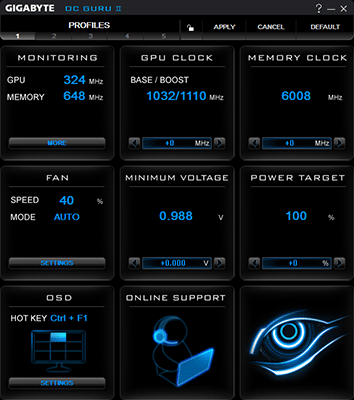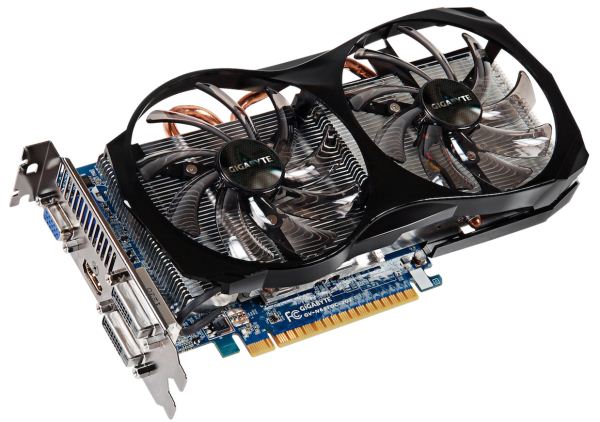The NVIDIA GeForce GTX 650 Ti Review, Feat. Gigabyte, Zotac, & EVGA
by Ryan Smith on October 9, 2012 9:00 AM ESTMeet The Gigabyte GeForce GTX 650 Ti OC 2GB Windforce
Our final card of the day is Gigabyte’s entry, the GeForce GTX 650 Ti OC 2GB. Like the other cards in today’s review this is a factory overclocked model, with Gigabyte shipping the core clock at 1033MHz, 107MHz (12%) over reference and the same overclock as Zotac. Meanwhile the memory clock is unchanged at 5.4GHz.
With the weakest factory overclock of the bunch, Gigabyte’s claim to fame here will be their design, which significantly deviates from NVIDIA’s reference design. The PCB itself is clearly based on NVIDIA’s (right down to the 5.75” length) and is otherwise unremarkable, but Gigabyte’s cooler is another Windforce 2X cooler, making it significant different from the much smaller open air coolers on the rest of the cards we’ve seen. Though the design of the cooler in use depends on the specific model of card, all of Gigabyte’s Windforce coolers share the same basic design, featuring a long aluminum heatsink that runs the length of the card (if not beyond), attached to the GPU through the use of copper heatpipes (2 in the case of the GTX 650 Ti).
Meanwhile air movement is provided by a pair of ridiculously large 100mm fans that run the length of the heatsink. In fact “ridiculously large” is about the single best two-word description there is for the GTX 650 Ti OC’s Windforce cooler. As we’ll see it’s going to be very effective, but in all likelihood it’s overkill out of the box. Because of the length (and significant overhang) of the Windforce cooler, Gigabyte’s card measures 9.3” long and you’ll need an extra inch of vertical clearance too to fit the behemoth.
Outside of cooling, Gigabyte’s card is otherwise very typical for a GTX 650 Ti. Gigabyte has equipped the card 2GB of Hynix 6GHz GDDR5, so when you overclock – and with a cooler this big you must – there is at a minimum a fair bit of memory headroom to play with. Meanwhile along with the minor PCB changes Gigabyte has changed the display ports to fit their needs. Gigabyte’s card uses a stacked DL-DVI-D design, augmenting that with a full-size HDMI port and a VGA port. With the increasing performance and ubiquity of iGPUs, VGA ports have finally started to fall out of favor, so Gigabyte is alone in shipping their card with a VGA port instead of a DVI-I to VGA dongle.
Rounding out the package is the usual collection of power adapters and a quick start guide. While it’s not included in the box or listed on the box, the Gigabyte GeForce GTX 650 Ti OC works with Gigabyte’s OC Guru II overclocking software, which is available on Gigabyte’s website. OC Guru isn’t quite up to the gold standard of overclocking software, but it’s functional, sleek, and gets the job done, which is great as with a cooler this large this card demands to be overclocked.

Wrapping things up, the Gigebyte GeForce GTX 650 Ti OC comes with Gigabyte’s standard 3 year warranty. Gigabyte will be releasing it at an MSRP of $174 ($169 without AC3), $25 over the price of a reference-clocked GTX 650 Ti and $5 less than the most expensive card in our roundup today.














91 Comments
View All Comments
chizow - Tuesday, October 9, 2012 - link
I guess in years past this may and probably should've been branded GTS 650Ti along with the GTS 650 (they've used GTS 250, GTS 450 etc in the past), but I know for a fact Nvidia is trying to establish GTX as its own brand for gamers.They really emphasize it with all this "Green Light" business with regard to overclocking, overvolting etc.
Blazorthon - Tuesday, October 9, 2012 - link
Nvidia has been cracking down on overvolting support, so IDK if I'd give them that much credit.Pneumothorax - Tuesday, October 9, 2012 - link
That will make the price/performance gap even worse as the 7850 is an oc beast.goinginstyle - Tuesday, October 9, 2012 - link
So why no reviews of the Asus or MSI offerings in these roundups?silverblue - Tuesday, October 9, 2012 - link
You need to be sent a card in order to review it. ;)Shadowmaster625 - Tuesday, October 9, 2012 - link
The 7850 1GB is $150. It IS is the direct competitor to the 650 ti. You can speculate all you want about the 1GB being some sort of ephemeral limiting factor, but I dont see it. All I see is that in one game, at BEYOND 1080p resolution, memory becomes a factor. But if you look at it, you can see that it is still so very close on the bell curve. I bet that if you actually tested Skyrim at 1920x1080 (not 1920x1200), there would be much less difference between 2GB and 1GB.Even 2 years from now the 7850 1GB is going to be a better performer than the 650ti. Even with the "latest and greatest" games.
Shark321 - Tuesday, October 9, 2012 - link
Where is the 7850 1GB $150?KineticHummus - Tuesday, October 9, 2012 - link
yeah wish i could fine one of those haha. pretty sure there isnt a single card for 150Marlin1975 - Tuesday, October 9, 2012 - link
How about $159 AR shipped?http://www.newegg.com/Product/Product.aspx?Item=N8...
LordanSS - Tuesday, October 9, 2012 - link
I'm a bit curious about this card's performance with PhysX enabled games.Personally, I am a 6970 owner and thus have no access to PhysX effects on games, but there are many workarounds out there where you can add a nVidia card to your machine to compute the physics.
Borderlands 2 is an example, I know of people buying (cheap) nVidia cards so they can run physics on them. Problem is that, most of the time, these guys are buying really old or cheap hardware (like GT210 or 430 cards), causing a big drop in game performance. Others using more powerful (and expensive) cards, on the other hand, experience good results.
So I'm thinking what's the cutting point for performance here. I know it's an extremely niche endeavor, but if anyone has experience or thoughts, I'd be glad to hear them.